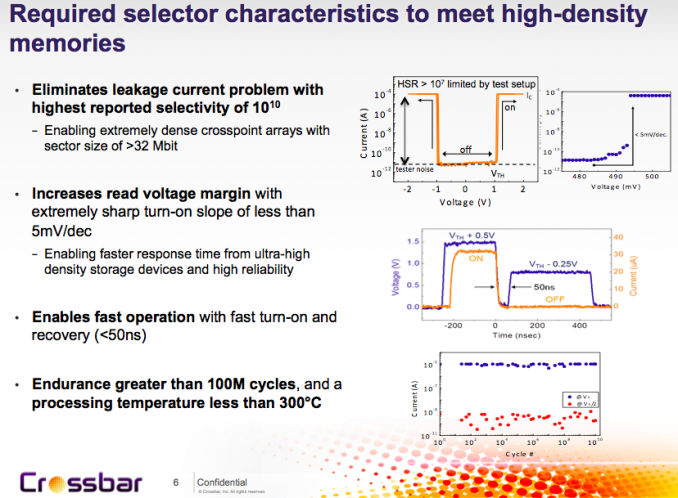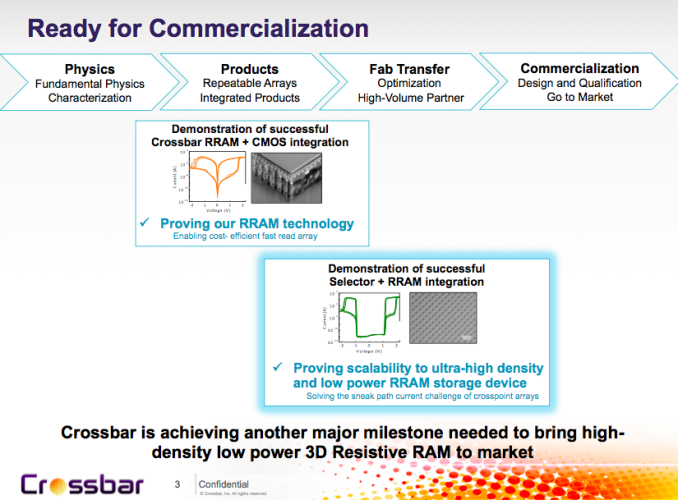Crossbar's Resistive RAM Technology Reaching Commercialisation Stage
by Kristian Vättö on December 21, 2014 4:35 PM EST- Posted in
- Storage
- SSDs
- Resistive RAM
- RRAM
- Crossbar

While the first 3D NAND chips have just found their way to the market and most NAND manufacturers are still developing their designs, there are already a handful of next generation memory technologies in development that are slated to supersede NAND in the next decade or so. One of the most promising technologies is Resistive Random Access Memory, which is more commonly referred to as Resistive RAM or just RRAM. Similar to NAND, RRAM is non-volatile, meaning that it will retain data without power unlike regular DRAM, which needs a continuous power source. Multiple companies are developing RRAM including semiconductor giants like Samsung and SanDisk, but Crossbar, a US based startup, has probably the most advanced design so far.
I've been following Crossbar for quite some time, but I haven't written anything about the company until now. The company was founded in 2010, headquarters in Santa Clara, California and has secured over $50 million in funding. The company's roots come from the University of Michigan and its Chief Scientist and co-founder, Prof. Wei Lu, is currently an associate professor at the university. The Crossbar team consists of 40-45 members at this point, of which most have extensive backgrounds in semiconductor research and development.
The big benefits RRAM have over NAND are performance and endurance. NAND read latencies are typically in the order of hundreds of microseconds, whereas Crossbar claims latency of as low as 50 nanoseconds for its RRAM design. Endurance in turn can be millions of program/erase cycles, although for the early designs Crossbar is aiming at more conservative ~100K cycles.
Last week at IEDM Crossbar announced that it is now entering the commercialization stage. In other words, it has already shown a working silicon and it has also proved that the design can be transferred to commercial fab for high volume manufacturing, so the company is now working with the fabs to build final products.
At first Crossbar is aiming at the embedded market and is licensing its technology to ASIC, FPGA and SoC developers with first samples arriving in early 2015, and mass production scheduled for late 2015 or early 2016. Aside from licensing, Crossbar is also developing standalone chips with higher capacity and density, which should enter the market about a year after the embedded RRAM designs (i.e.most likely sometime in 2017).
The beauty of RRAM is that it can be manufactured using a regular CMOS process with only a few modifications. NAND and especially 3D NAND require expensive special tools (for things like high aspect ratio etching), which is why only a handful of companies are making 3D NAND. RRAM in turn can be manufactured by practically any existing fab with very little added cost, which ultimately results in lower prices due to more competition.
Additionally, RRAM doesn't share NAND's lithography issues. As we know, the sole reason why 3D NAND was invented is because planar NAND can't really scale below 15nm without serious endurance and performance considerations. However, RRAM can efficiently scale to 4-5nm without any issues and in fact Crossbar has already demonstrated an 8nm chip that it built in its R&D labs (most likely using multiple patterning). Moreover, RRAM can be stacked vertically to create a 3D crosspoint array for increased density and so far Crossbar is at three layers, but first commercial standalone chips are expected to feature 16 layers and up to 1Tbit capacity.
Obviously, there are still several hurdles to cross before RRAM is ready to challenge NAND, but it's good to hear that there has been significant progress in development and the technology has gained interest from the fab companies. Faster, more durable and cheaper SSDs and other storage devices are a win for everyone and ultimately even 3D NAND is just an interim solution until something better comes around, which may very well be RRAM. I'll be doing a more in-depth article about RRAM technology in the coming months as this article was more of a heads up about the state of RRAM and Crosspoint's recent developments, so stay tuned for a deeper analysis!












65 Comments
View All Comments
Gigabob - Monday, December 22, 2014 - link
I too have followed the Crossbar story for a few years. Meanwhile I hear bupkis from RRAM "leader" HP - who expects to lead with this technology for "The Machine". I don't see any reason our friends at Micron/Intel can't move this into production once they feel the time is right.I hope Crossbar can go from design win to commercial products - but not holding breath for a Crossbar SSD. Appreciate the need to scale up - but with Volume production using 3D NAND at 40-44nm - for Intel the production cost hurdle for RRAM to undercut in 3 years will be nontrivial.
I used to worry Crossbar would be another A123 and end up in China, but doubt they can capture that kind of imagination or funding - which explains the SoC and embedded focus.
HisDivineOrder - Tuesday, December 23, 2014 - link
This article reminds me of OLED, which was going to supplant LCD in our monitors.Doubt it. Maybe if (or rather when) "Crossbar" is bought up by Samsung or Toshiba.
FunBunny2 - Friday, December 26, 2014 - link
Crossbar, by that name, has been licensed from IBM, although not by Crossbar the company, so far as I know.MRFS - Saturday, January 3, 2015 - link
Keeping things simple, I can see RRAM fitting into the existing workstation and server ecosystems with the following: (a) an RRAM replacement for SanDisk's UltraDIMM (but OS changes may be required) (b) a 1-for-1 replacement for existing 2.5" Nand Flash SSDs, but with a "SATA-IV" interface using the PCIe 3.0 128b/130b "jumbo frame" and 8GHz clock rate, scaling up sooner (or later) to 12G and 16G either with jumpers, option ROMs or auto-detection (c) pre-loading the OS once into an upper region of very large main memory subsystems e.g. 1TB and leaving it there e.g.for an "instant ON" Windows Desktop (just like a light switch :) (d) my favorite is to integrate RRAM chips on the SODIMM form factor for high-density solutions (e) don't forget, RAID technology is very mature, and speed can be easily configurable with 4x, 8x 12x and 16x SSDs: choose your RAID mode (f) tons of additional applications I haven't even thought of yet. NTFS will not need changing if existing SATA and SAS protocols are implemented at the storage end of the data cables.MRFS - Saturday, January 3, 2015 - link
A while back we filed a provisional patent application for loading Windows directly into a ramdisk: this can be implemented more easily now with UEFI technology. Just add a "Format RAM" option so as to make that NTFS partition transparent to Windows Setup, and then install Windows directly into that ramdisk e.g. call it "C:" The key here, of course, is that the RRAM is non-volatile, just like HDDs and Nand Flash SSDs, so the OS will still be there whenever the user invokes Shutdown. I can also see motherboards that support hybrid DIMM socket regions -- one subset for super high-speed operations e.g. DDR4+, and the other subset for storing the OS at run-time. Properly implemented, the latter subset operates just like the C: system partition in billions of NTFS implementations now running AOK all around the world, but withOUT any of the penalties of HDDs and existing Nand Flash SSDs. Think "RamDisk Plus" from SuperSpeed, LLC, but without the penalty of pre-loading each ramdisk at every Startup.